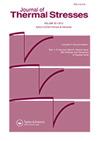恒流充电条件下锂离子电池层状电极的热扩散应力
IF 2.6
3区 工程技术
Q2 MECHANICS
引用次数: 0
摘要
摘要锂离子电池在充电过程中会产生热量和体积变化,由于热和扩散不匹配,导致有源极板和集流器之间产生内应力。过大的应力会导致电极断裂,导致电池的机械和电气故障。本文给出了恒流充电过程中锂离子电池内部温度和浓度分布的解析解,并对层状电极的相关热应力和扩散应力进行了预测。数值分析表明,在评估电极的应力状态时,考虑电化学充电过程中产生的热量是非常重要的。为了防止热失控,确保大电流充电时的有效散热是至关重要的。在活动板块的侧面观察到最大应力,突出了热应力在减少扩散诱发应力中的重要性。此外,采用具有较高热膨胀系数和较低弹性模量的集流器可以减轻活动板上的总体应力。本文为锂离子电池充电策略的参数化研究和优化提供了有价值的理论模型。关键词:对流传热扩散诱导应力层状锂离子电池温度披露声明作者未报告潜在利益冲突。数据可得性声明支持本研究结果的数据可根据通讯作者的合理要求获得。本研究得到浙江省自然科学基金[LY21A020004]、宁波市自然科学基金[2022J095]和中国留学基金委[202208330228]的资助。本文章由计算机程序翻译,如有差异,请以英文原文为准。
Thermal and diffusion induced stresses of layered electrodes in the lithium-ion battery under galvanostatic charging
AbstractDuring the charging process of a lithium-ion battery, heat generation and volume changes occur, leading to internal stresses between the active plates and current collectors due to thermal and diffusivity mismatch. Excessive stresses can result in electrode fracture, causing mechanical and electrical failures of the battery. This paper presents analytical solutions for the temperature and concentration distribution inside the lithium-ion battery during galvanostatic charging, and the associated thermal and diffusion induced stresses of layered electrode are also predicted. Numerical analysis demonstrates the importance of considering the generated heat during electrochemical charging when assessing the stress state of the electrodes. To prevent thermal runaway, it is crucial to ensure efficient heat dissipation during high-current charging. The maximum stress is observed at the lateral surfaces of the active plates, highlighting the significance of thermal stress in reducing the diffusion induced stress. Furthermore, employing a current collector with a higher coefficient of thermal expansion and lower elastic modulus can mitigate the overall stress on the active plate. This paper offers a valuable theoretical model for parametric studies and optimization of charging strategies for lithium-ion batteries.Keywords: Convective heat transferdiffusion induced stresslayered electrodelithium-ion batterytemperature Disclosure statementNo potential conflict of interest was reported by the author(s).Data availability statementThe data that support the findings of this study are available from the corresponding author upon reasonable request.Additional informationFundingThe research was supported by the Natural Science Foundation of Zhejiang Province of China [LY21A020004], the Natural Science Foundation of Ningbo [2022J095] and the China Scholarship Council [202208330228].
求助全文
通过发布文献求助,成功后即可免费获取论文全文。
去求助
来源期刊

Journal of Thermal Stresses
工程技术-力学
CiteScore
5.20
自引率
7.10%
发文量
58
审稿时长
3 months
期刊介绍:
The first international journal devoted exclusively to the subject, Journal of Thermal Stresses publishes refereed articles on the theoretical and industrial applications of thermal stresses. Intended as a forum for those engaged in analytic as well as experimental research, this monthly journal includes papers on mathematical and practical applications. Emphasis is placed on new developments in thermoelasticity, thermoplasticity, and theory and applications of thermal stresses. Papers on experimental methods and on numerical methods, including finite element methods, are also published.
 求助内容:
求助内容: 应助结果提醒方式:
应助结果提醒方式:


